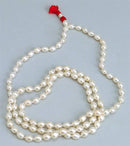Here 108 pearl beads are nicely put together to create the japa mala. A Japa mala is an essential ingredient for meditation. Basically it is a set of beads usually made from 108 beads, though other numbers are also used. Malas are used for keeping a tab on reciting, chanting, or mentally repeating a mantra or names of a deity.
Mantras are repeated hundreds or even thousands of times. The mala is used so that one can focus on the meaning or sound of the mantra. One repetition is usually said for each bead while turning the thumb clockwise around each bead. When arriving at the head bead, one turns the mala around and then goes back in the opposing direction. There are typically knots between each bead. This makes using the mala easier as the beads will not be so tight on the string when you use them.
There are numerous explanations as to why 108 beads are used in a japa mala.
Some suggest that there are 108 paths to God. Some say there are 108 feelings, with 36 related to the past, 36 related to the present, and 36 related to the future. There are said to be 108 earthly desires in mortals and also 108 lies that humans tell.
There are said to be 108 human delusions or forms of ignorance. Some say there are 108 Upanishads, texts of the wisdom of the ancient sages. In astrology, there are 12 houses and 9 planets. 12 times 9 equals 108.
There are said to be 108 Indian goddess names. In the Krishna tradition, there were said to be 108 gopis or maid servants of Krishna.
In doing a practice of counting the number of repetitions of the mala, 100 are counted as completed. The remaining are said to cover errors or omissions. The 8 are also said to be an offering to God and Guru. Some say there are 108 styles of meditation.
Tantra estimates the average number of breaths per day at 21,600, of which 10,800 are solar energy, and 10,800 are lunar energy. Multiplying 108 by 100 is 10,800. Multiplying 2 x 10,800 equals 21,600.
Some suggest that there are 108 paths to God and Atman, the human soul goes through 108 stages on the journey.
In case more than 108 repetitions are to be done, then sometimes in Tibetan traditions grains of rice are counted out before the chanting begins and one grain is placed in a bowl for each 108 repetitions.
The 109th bead on a mala is called the sumeru, bindu, stupa, or guru bead. Counting should always begin with a bead next to the sumeru. In the Hindu, Vedic tradition, if more than one mala of repetitions is to be done, one changes directions when reaching the sumeru rather than crossing it.
Some Hindu traditions hold that the correct way to use a mala is with the right hand, with the thumb flicking one bead to the next, and with the mala draped over the middle finger. The index finger represents ego, the greatest impediment to self-realization, so it is considered best avoided when chanting on a mala.
In northeast India, particularly those in the Shakta traditions in West Bengal and Assam, the mala is often draped on the ring finger of the right hand, with beads moved by the middle finger with aid of the thumb and avoiding the use of the index finger.
A number of materials are used to make mala beads. Beads made from the seeds of the rudraksha tree are considered sacred by Saivas, devotees of Siva, while beads made from the wood of the tulsi plant are used and revered by Vaishnavas, followers of Vishnu. Other common beads include wood or seeds from the sandalwood tree or the Bodhi tree, and seeds of the Lotus plant. Some Tibetan Buddhist traditions call for the use of animal bone (most commonly yak), but sometimes human bone is used, those of past Lamas being the most valuable. Semiprecious stones such as carnelian and amethyst may be used, as well. In Hindu Tantra, as well as Buddhist Tantra (or Vajrayana), materials and colors of the beads can relate to a specific practice.
Description
Here 108 pearl beads are nicely put together to create the japa mala. A Japa mala is an essential ingredient for meditation. Basically it is a set of beads usually made from 108 beads, though other numbers are also used. Malas are used for keeping a tab on reciting, chanting, or mentally repeating a mantra or names of a deity.
Mantras are repeated hundreds or even thousands of times. The mala is used so that one can focus on the meaning or sound of the mantra. One repetition is usually said for each bead while turning the thumb clockwise around each bead. When arriving at the head bead, one turns the mala around and then goes back in the opposing direction. There are typically knots between each bead. This makes using the mala easier as the beads will not be so tight on the string when you use them.
There are numerous explanations as to why 108 beads are used in a japa mala.
Some suggest that there are 108 paths to God. Some say there are 108 feelings, with 36 related to the past, 36 related to the present, and 36 related to the future. There are said to be 108 earthly desires in mortals and also 108 lies that humans tell.
There are said to be 108 human delusions or forms of ignorance. Some say there are 108 Upanishads, texts of the wisdom of the ancient sages. In astrology, there are 12 houses and 9 planets. 12 times 9 equals 108.
There are said to be 108 Indian goddess names. In the Krishna tradition, there were said to be 108 gopis or maid servants of Krishna.
In doing a practice of counting the number of repetitions of the mala, 100 are counted as completed. The remaining are said to cover errors or omissions. The 8 are also said to be an offering to God and Guru. Some say there are 108 styles of meditation.
Tantra estimates the average number of breaths per day at 21,600, of which 10,800 are solar energy, and 10,800 are lunar energy. Multiplying 108 by 100 is 10,800. Multiplying 2 x 10,800 equals 21,600.
Some suggest that there are 108 paths to God and Atman, the human soul goes through 108 stages on the journey.
In case more than 108 repetitions are to be done, then sometimes in Tibetan traditions grains of rice are counted out before the chanting begins and one grain is placed in a bowl for each 108 repetitions.
The 109th bead on a mala is called the sumeru, bindu, stupa, or guru bead. Counting should always begin with a bead next to the sumeru. In the Hindu, Vedic tradition, if more than one mala of repetitions is to be done, one changes directions when reaching the sumeru rather than crossing it.
Some Hindu traditions hold that the correct way to use a mala is with the right hand, with the thumb flicking one bead to the next, and with the mala draped over the middle finger. The index finger represents ego, the greatest impediment to self-realization, so it is considered best avoided when chanting on a mala.
In northeast India, particularly those in the Shakta traditions in West Bengal and Assam, the mala is often draped on the ring finger of the right hand, with beads moved by the middle finger with aid of the thumb and avoiding the use of the index finger.
A number of materials are used to make mala beads. Beads made from the seeds of the rudraksha tree are considered sacred by Saivas, devotees of Siva, while beads made from the wood of the tulsi plant are used and revered by Vaishnavas, followers of Vishnu. Other common beads include wood or seeds from the sandalwood tree or the Bodhi tree, and seeds of the Lotus plant. Some Tibetan Buddhist traditions call for the use of animal bone (most commonly yak), but sometimes human bone is used, those of past Lamas being the most valuable. Semiprecious stones such as carnelian and amethyst may be used, as well. In Hindu Tantra, as well as Buddhist Tantra (or Vajrayana), materials and colors of the beads can relate to a specific practice.
Payment & Security
Your payment information is processed securely. We do not store credit card details nor have access to your credit card information.




